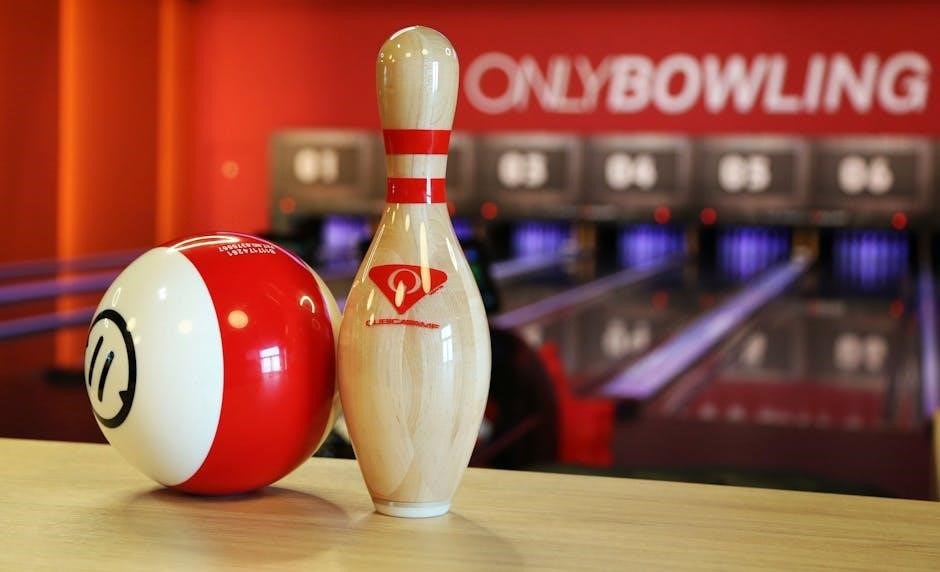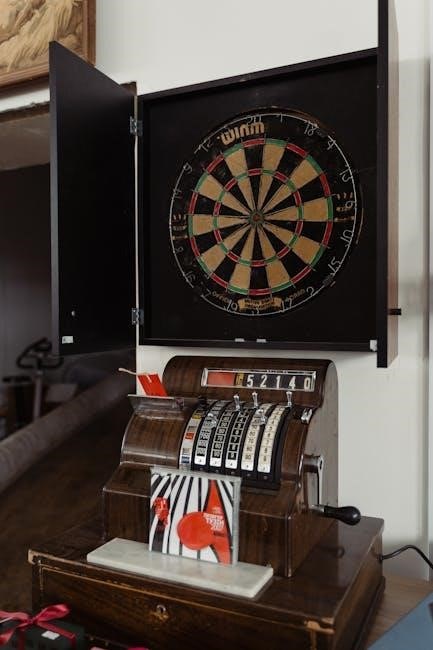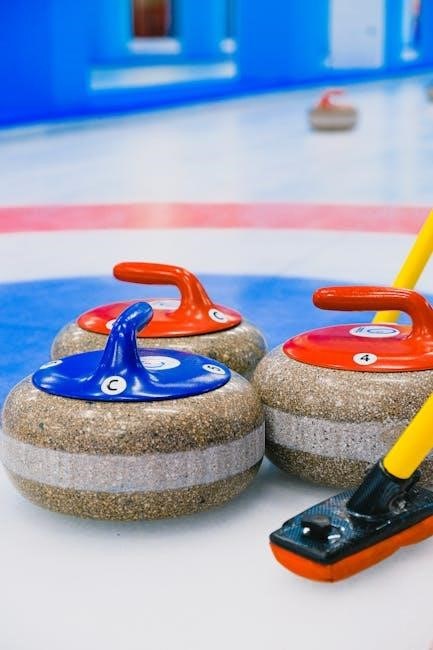Overview of the FTC Center Stage Game Manual 2
The FTC Center Stage Game Manual 2 is the official guide for the 2023-2024 season‚ detailing rules‚ gameplay strategies‚ and technical requirements. It ensures fair competition while promoting innovation and teamwork among participants.
1.1 Importance of the Manual for Teams
The FTC Center Stage Game Manual 2 is essential for teams to understand competition rules‚ scoring systems‚ and robot specifications. It ensures compliance‚ fairness‚ and optimal performance. Teams rely on this guide to prepare strategies‚ design robots‚ and adhere to gameplay regulations. The manual promotes Gracious Professionalism‚ fostering collaboration and sportsmanship. By following its guidelines‚ teams can maximize their competitive edge and navigate challenges effectively throughout the season.
1.2 Key Features and Updates in the 2023-2024 Season
The FTC Center Stage Game Manual 2 for the 2023-2024 season includes updated rules‚ scoring systems‚ and robot specifications. It introduces new gameplay mechanics‚ enhanced autonomous and driver-controlled period guidelines‚ and revised compliance standards. The manual emphasizes fair competition‚ innovation‚ and Gracious Professionalism‚ providing teams with clear instructions to optimize performance and strategy. These updates ensure an engaging and competitive experience for all participants.

Gameplay Rules and Regulations
The FTC Center Stage Game Manual 2 outlines essential gameplay rules‚ ensuring fair and consistent competition. It covers match structure‚ scoring‚ and robot interactions‚ promoting a balanced playing field.
2.1 Autonomous and Driver-Controlled Periods
The FTC Center Stage Game Manual 2 divides gameplay into two key periods: Autonomous and Driver-Controlled. The Autonomous period lasts 15 seconds‚ where robots operate independently using pre-programmed instructions. This phase emphasizes precise coding and sensor accuracy to achieve tasks without human intervention. The Driver-Controlled period follows‚ allowing teams to manually operate their robots using gamepads‚ focusing on strategic gameplay and real-time decision-making. Both periods require efficient robot design and programming to maximize performance and scoring potential during matches.
2.2 Scoring Systems and Point Allocation
The FTC Center Stage Game Manual 2 outlines a structured scoring system to reward specific actions during matches. Points are awarded for tasks such as scoring goals‚ completing autonomous routines‚ and achieving endgame bonuses. Autonomous actions‚ like precision moves‚ earn higher points due to their complexity. Penalties for fouls or rule violations deduct points‚ emphasizing the importance of strategic gameplay. Teams must balance scoring opportunities with defensive tactics to maximize their overall score and secure a competitive edge in the rankings.
2.3 Robot Specifications and Compliance
The FTC Center Stage Game Manual 2 provides detailed specifications for robot design‚ ensuring safety and fairness. Robots must adhere to size limits‚ weight restrictions‚ and material guidelines. Only approved components are permitted‚ and teams must pass pre-match inspections to confirm compliance. Programming guidelines are also outlined to prevent unfair advantages. Failure to meet these standards results in penalties or disqualification‚ emphasizing the importance of careful planning and adherence to rules for a competitive yet equitable environment.

Robot Design and Construction
This section covers essential design principles‚ materials‚ and construction techniques for building competitive robots. It emphasizes safety‚ durability‚ and compliance with FTC guidelines‚ ensuring optimal performance and reliability.
3.1 Design Considerations for Optimal Performance
Effective robot design balances functionality‚ durability‚ and adaptability. Prioritize weight distribution for stability‚ ensuring smooth mobility and maneuverability. Incorporate modular components for easy maintenance and upgrades. Consider scalability to accommodate evolving game strategies. Focus on energy efficiency to maximize runtime and performance. Ensure designs align with FTC regulations and safety standards. A well-planned structure enhances reliability and competitiveness‚ enabling teams to adapt to dynamic match conditions and achieve peak performance.
3.2 Materials and Components Allowed
The FTC Center Stage Game Manual 2 specifies allowable materials and components for robot construction. Teams can use aluminum‚ polycarbonate‚ and approved plastics‚ as well as 3D-printed parts. Motors‚ servos‚ and actuators must be from approved suppliers. Pneumatics and certain sensors are permitted‚ but latex and non-FDA-approved plastics are prohibited. Programming languages like Java‚ Kotlin‚ and Python are allowed for robot control. Ensure all components comply with FTC regulations to avoid penalties and maintain eligibility for competition.
3.3 Programming Guidelines for Robot Operations
Programming for FTC robots must adhere to specific guidelines. Teams can use approved languages like Java‚ Kotlin‚ and Python. Code should be structured to handle autonomous and driver-controlled modes. Sensors and motors must be accurately programmed for precise operations; Teams are encouraged to use modular code for easier maintenance. Testing and iteration are crucial to ensure reliability. Compliance with FTC rules‚ such as no external data sources‚ is mandatory. Proper documentation and consistent version control are recommended for effective collaboration.

Match Setup and Structure
The FTC match setup involves alliances‚ field layout‚ and timing. Teams must understand roles‚ strategies‚ and communication to ensure smooth gameplay and rule adherence.
4.1 Pre-Match Preparation and Inspection
Pre-match preparation involves thorough robot inspection‚ ensuring compliance with game rules. Teams must check mechanical systems‚ electrical connections‚ and software functionality. Inspection includes verifying autonomous modes‚ reviewing documentation‚ and confirming all components meet specifications. Referees conduct final checks to ensure robots are competition-ready. Proper preparation prevents disqualification and ensures smooth gameplay. Teams have a limited time for setup‚ making efficiency critical. Failure to pass inspection can result in penalties or inability to compete.
4.2 Alliance System and Team Pairings
In FTC competitions‚ teams are paired into alliances‚ typically consisting of two teams per match. Pairings are often randomized but may involve strategic selections in later rounds. Effective communication and coordination between alliance partners are crucial for maximizing points. Teams must understand each other’s strengths and weaknesses to execute game strategies efficiently. Penalties may occur if alliances fail to coordinate properly. The alliance system fosters collaboration and mutual success‚ aligning with FTC’s core values of teamwork and gracious professionalism.
4.3 Field Layout and Key Zones
The FTC Center Stage field is strategically designed with distinct zones to facilitate gameplay. The Scoring Zone is where robots deposit game elements for points‚ while the Penalty Zone imposes penalties for unauthorized entry. Other key areas include the Alliance Station for robot starting positions and the Neutral Zone for transitional movements. Understanding these zones is vital for tactical gameplay and maximizing scoring opportunities during matches. Proper navigation ensures compliance with rules and avoids unnecessary penalties.

Autonomous Period Strategies

Mastering autonomous strategies is crucial for early scoring and setting the tone for the match. Focus on precision movements and targeting high-value zones to maximize points efficiently.
5.1 Effective Autonomous Algorithms
Developing robust autonomous algorithms ensures precise robot movements and consistent scoring. Focus on motion planning‚ sensor integration‚ and decision-making logic to optimize performance. Use gyroscopes and IMU for accurate navigation‚ and implement pathfinding algorithms to efficiently reach scoring zones. Ensure algorithms adapt to field conditions and alliance partner actions. Regular testing and iteration refine reliability and effectiveness‚ maximizing points during the autonomous period.
5.2 Maximizing Points in Autonomous Mode
To maximize points in autonomous mode‚ prioritize high-value tasks like scoring in specific zones or completing challenging actions. Focus on precision and speed to execute complex maneuvers reliably. Use sensors and vision systems to detect and adapt to field elements. Ensure the algorithm is efficient‚ minimizing wasted time. Regularly test and refine autonomous routines to improve accuracy and consistency‚ ensuring optimal point accumulation during the autonomous period.
5.3 Common Pitfalls to Avoid
Avoid overcomplicating autonomous routines‚ as this can lead to reliability issues. Ensure all sensors are properly calibrated to prevent navigation errors. Overreliance on vision systems can fail in low-light conditions. Inconsistent testing may result in unpredictable performance during matches. Neglecting to account for alliance partner movements can disrupt coordinated strategies. Lastly‚ poorly timed sequences may waste valuable seconds‚ reducing potential points. Address these issues through rigorous testing and refinement.

Driver-Controlled Period Tactics
Efficient maneuvering‚ quick decision-making‚ and clear communication between drivers and alliance partners are crucial for maximizing points during the driver-controlled period and ensuring strategic positioning for success.
6.1 Efficient Gameplay During Driver Control
Efficient gameplay during driver control requires precise skill‚ strategic coordination‚ and quick decision-making. Drivers must focus on rapid scoring‚ prioritizing high-value tasks while minimizing wasted time; Effective communication between alliance partners ensures synchronized actions‚ maximizing collective points. Robots should be maneuvered to block opponents or defend scoring zones when beneficial. Mastery of controls and knowledge of the field layout are critical for optimal performance during this high-intensity phase.
6.2 Coordinating with Alliance Partners
Coordinating with alliance partners is crucial for achieving shared goals during matches. Clear communication ensures synchronized actions‚ maximizing scoring opportunities. Teams should pre-agree on strategies and roles to avoid conflicts. Adaptability is key‚ as plans may change based on game progression. Effective coordination enhances efficiency‚ allowing both teams to focus on high-value tasks. Mutual support‚ such as assisting with game piece retrieval‚ strengthens overall performance and fosters a collaborative environment. Seamless teamwork often leads to higher scores and better match outcomes.
6.3 Defense and Blocking Strategies
Effective defense involves positioning your robot to disrupt opponents’ movements and scoring attempts. Blocking access to key zones‚ such as the scoring tower or power portals‚ can significantly hinder their progress. Timing and precision are critical to intercepting opponents without causing penalties. Defense should complement offensive play‚ ensuring your alliance maintains momentum. Coordination with your partner allows for balanced gameplay‚ focusing on both scoring and disrupting opponents. A well-executed defense can neutralize threats and secure victory.

Penalties and Violations
Penalties and violations are crucial aspects of fair play in FTC competitions. Understanding and adhering to rules ensures smooth gameplay and maintains the integrity of the match‚ promoting a respectful environment for all participants.
7.1 Common Penalties and Their Impact
Common penalties in FTC competitions include illegal moves‚ unsportsmanlike conduct‚ and interference with opponents. These violations can result in point deductions or disqualification‚ impacting a team’s overall performance. Understanding these penalties is crucial for maintaining fair play and ensuring a competitive yet respectful environment. Teams must adhere to rules to avoid such issues‚ as repeated violations can escalate consequences‚ potentially leading to match disqualification or tournament penalties. Awareness and rule compliance are vital for success and maintaining sportsmanship.
7.2 Avoiding Violations and Maintaining Gracious Professionalism
Avoiding violations requires a deep understanding of the rules and proactive teamwork. Gracious professionalism‚ a core FTC value‚ emphasizes respect‚ sportsmanship‚ and integrity. Teams should ensure all actions align with the manual’s guidelines to prevent penalties. Regular rule reviews‚ pre-match inspections‚ and clear communication can help avoid violations. Encouraging a culture of respect fosters collaboration and maintains a positive competitive environment. Upholding these principles ensures fair play and strengthens team reputation.

Expert Strategies for Success
Expert strategies focus on optimizing robot performance‚ mastering advanced techniques‚ and maximizing scoring opportunities. Teams can enhance gameplay by refining autonomous algorithms and driver-controlled tactics‚ ensuring seamless execution.
8.1 Tips for Optimizing Robot Performance
To optimize robot performance‚ focus on refining autonomous algorithms for accuracy and speed. Ensure sensors are calibrated and programming is error-free. Lightweight yet durable materials enhance maneuverability. Regularly test and tweak mechanisms for reliability. Streamline code to reduce processing time. Implement efficient gear ratios for maximum torque and speed. Practice driver-robot synchronization to minimize errors. Maintain a clean and organized wiring setup to prevent technical issues during matches. These strategies collectively enhance overall performance and competitiveness.
8.2 Advanced Scoring Techniques
Maximize points by optimizing autonomous and driver-controlled actions. Prioritize high-value tasks like stacking‚ row bonuses‚ and alliance coordination. Utilize endgame bonuses effectively‚ such as park and climb actions. Focus on efficient use of Super Cells and cargo cycles. Coordinate with alliance partners to achieve shared bonuses. Plan routes to minimize waste and maximize scoring opportunities. Avoid penalties that negate points. Advanced strategies like simultaneous actions and timing optimizations can significantly boost your score‚ ensuring competitive performance in matches.
8.3 Pre-Competition Checklist
Ensure your robot passes inspection by verifying compliance with all rules. Test and charge batteries‚ and secure loose parts. Review and debug autonomous programs for reliability. Confirm all game pieces are legally stored. Practice alliance communication to align strategies. Double-check timing for endgame actions. Ensure all team members understand their roles. Test robot mobility and functionality on the field. Address any technical issues beforehand to avoid match penalties. A thorough checklist ensures readiness and minimizes risks during competition.
Troubleshooting Common Issues
Identify root causes of mechanical or software malfunctions. Test and iterate on solutions. Use diagnostics tools to pinpoint issues. Address connectivity problems promptly. Stay calm and methodical during repairs.
9.1 Identifying and Fixing Technical Problems
Start by identifying the root cause of the issue‚ whether it’s a mechanical‚ electrical‚ or software malfunction. Use debug logs and sensor data to isolate problems. Test individual components to ensure functionality. For connectivity issues‚ check wires and Pair devices properly. Collaborate with team members to brainstorm solutions. Document fixes for future reference and improve reliability. Regularly update software and firmware to avoid compatibility issues. Always test repairs in a controlled environment before match deployment.
9.2 Adapting to Unexpected Challenges
Unexpected challenges‚ like mechanical failures or field issues‚ require quick thinking. Stay calm and assess the situation methodically. Leverage prior knowledge and experience to devise solutions. Communicate clearly with teammates to align on strategies. Have backup plans ready‚ such as spare parts‚ to minimize downtime. Be prepared to pivot strategies if necessary. Trust in your preparation and remain flexible to ensure optimal performance under pressure‚ reflecting FTC’s values of gracious professionalism and adaptability.

Resources and References
Essential materials include official FTC guides‚ community tutorials‚ and updated rulebooks‚ providing teams with comprehensive tools to master the FTC Center Stage Game Manual 2 effectively.
10.1 Official FTC Documentation
The FTC provides detailed official documentation‚ including rulebooks‚ technical guides‚ and update summaries. These resources‚ available on the FTC website‚ ensure teams understand game rules‚ robot construction‚ and scoring systems. Official documents are regularly updated to reflect the latest changes for the Center Stage Game Manual 2. Teams can access official FAQs‚ webinars‚ and Q&A forums for clarifications. These resources are essential for compliance and competitive success‚ offering a comprehensive understanding of the game’s requirements and expectations.
10.2 Community Guides and Tutorials
Community guides and tutorials are invaluable resources for teams navigating the FTC Center Stage Game Manual 2. These materials‚ created by experienced teams and mentors‚ offer practical insights and tips. They cover topics like robot design‚ programming strategies‚ and game-specific tactics. Many are available on platforms like YouTube‚ forums‚ and team websites. These community-driven resources complement official documentation‚ providing real-world examples and helping teams troubleshoot common challenges. They foster collaboration and innovation within the FTC community‚ enabling teams to refine their approaches effectively.
The FTC Center Stage Game Manual 2 is a comprehensive guide empowering teams to excel. Mastery requires dedication‚ teamwork‚ and continuous learning. Prepare thoroughly for success.
11.1 Final Thoughts on Mastering the FTC Center Stage Game Manual 2
Mastery of the manual requires a deep understanding of rules‚ strategies‚ and teamwork. Balance innovation with execution‚ and stay adaptable. Continuous improvement and sportsmanship are key to long-term success in FTC competitions. Embrace challenges‚ learn from setbacks‚ and collaborate effectively. By doing so‚ teams can unlock their full potential and achieve excellence in the FTC Center Stage Game Manual 2.
11.2 Preparing for Future Competitions
Preparing for future competitions involves reviewing past performances‚ refining strategies‚ and staying updated on rule changes. Teams should focus on improving robot design‚ programming‚ and teamwork. Practice matches and simulations can help identify weaknesses. Encourage continuous learning‚ adaptability‚ and innovation. Building a strong foundation now ensures readiness for upcoming challenges and fosters long-term success in FTC competitions.






